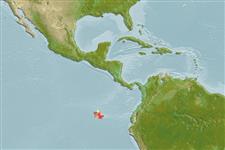分类 / Names
俗名 | 同种异名 | Catalog of Fishes(属, 种) | ITIS | CoL | WoRMS | Cloffa
Teleostei >
Ophidiiformes (Cusk eels) >
Dinematichthyidae (Viviparous brotula)
Etymology: Ogilbia: Taken from Ogilby, 1887-1915, icthiologist and zoologist (Ref. 45335).
More on authors: Poll & vanMol.
Environment: milieu / climate zone / depth range / distribution range
生态学
海洋 礁区鱼类; 深度上下限 0 - 10 m (Ref. 57883). 熱帶
Southeast Pacific: Galapagos Islands.
東南太平洋: 加拉巴哥群島。
大小 / 重量 / 年龄
Maturity: Lm ? range ? - ? cm
Max length : 7.0 cm TL 雄鱼/尚未辨别雌雄; (Ref. 11482)
背的软条 (总数): 68-80; 臀鳍软条: 51 - 59; 脊椎骨: 39 - 43. This species is characterized by the following: vertebrae 11-12 + 27-31 = 39-43, dorsal fin rays 68-80, anal fin rays 51-59; outer pseudoclasper with a broad base and long supporter with sharp, pointed tip; inner pseudoclasper is anteriorly inclined, of about length of outer pseudoclasper, with sharp, spine-like tip anteriorly and fleshy flap posteriorly; isthmus between pseudoclaspers wide, penis with abrupt change in thickness; opercular spine with a single, sharp tip; cheeks naked or with few isolated scales (less than 10 scales all together); otolith length: height ratio 2.1-2.2; upper preopercular pore absent (Ref. 57883).
Inhabits rocky crevices (Ref. 11482). Two paratypes that were collected at low tide between blocks of lava in about 50 cm of water, were observed to move slowly close to the sand bottom. Experiments that were carried out showed that O. deroyi can tolerate a wide
variation in salinity, but not the low salinity in which O. galapagosensis lives. Consequently, there is an ecological barrier separating the two species. Only about five embryos were observed in ripe females (Ref. 57883).
栖息于岩石的裂隙。 (参考文献 11482)
Life cycle and mating behavior
成熟度 | 繁殖 | 产卵场 | 卵 | 孕卵数 | 仔鱼
東南太平洋: 加拉巴哥群島。
Møller, P.R., W. Schwarzhans and J.G. Nielsen, 2005. Review of the American Dinematichthyini (Teleostei: Bythitidae). Part II. Ogilbia. aqua, J. Ichthyol. Aquat. Biol. 10(4):133-207. (Ref. 57883)
人类利用
渔业: 没有兴趣
更多信息
俗名同种异名新陈代谢捕食者生态毒物学繁殖成熟度产卵场产卵群集孕卵数卵卵的发育
参考文献养殖养殖信息品种遗传学Electrophoreses遗传率疾病加工NutrientsMass conversion
合作者照片Stamps, Coins Misc.声音神经毒速度泳型鳃区Otoliths脑重体重比眼睛色素
工具
特别资料
下载 XML
网络资源
Estimates based on models
Preferred temperature (Ref.
123201): 23.6 - 24.6, mean 23.9 °C (based on 12 cells).
Phylogenetic diversity index (Ref.
82804): PD
50 = 0.5000 [Uniqueness, from 0.5 = low to 2.0 = high].
Bayesian length-weight: a=0.00389 (0.00180 - 0.00842), b=3.12 (2.94 - 3.30), in cm total length, based on all LWR estimates for this body shape (Ref.
93245).
营养阶层 (Ref.
69278): 3.3 ±0.5 se; based on size and trophs of closest relatives
回复力 (Ref.
120179): 低的, 最小族群倍增时间4.5 - 14 年 (Assuming Fec < 100).
Fishing Vulnerability (Ref.
59153): Low vulnerability (10 of 100).
